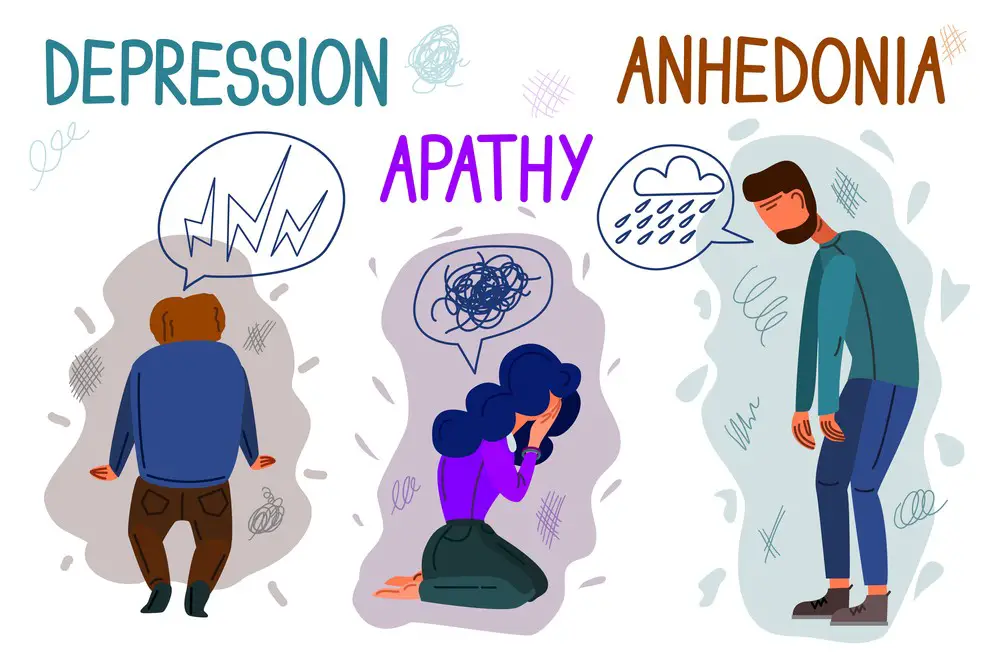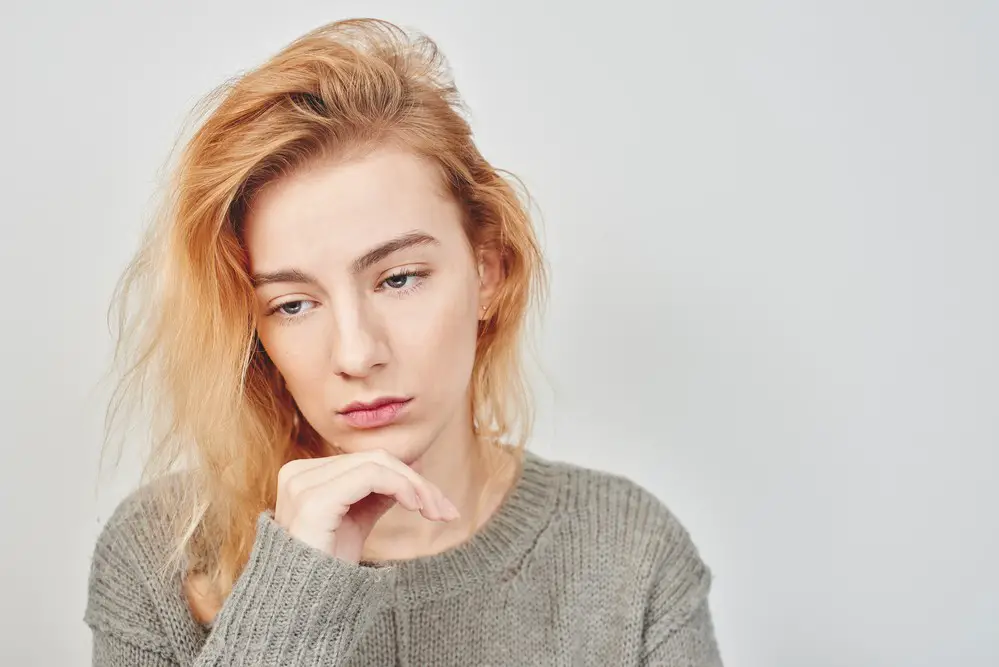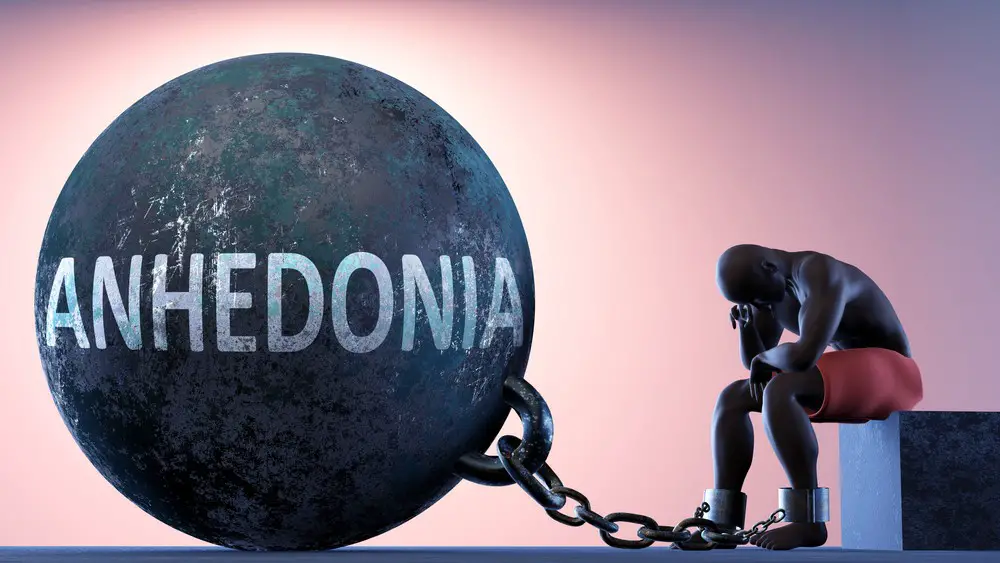As a BetterHelp affiliate, we receive compensation from BetterHelp if you purchase products or services through the links provided
Anhedonia, a symptom commonly associated with depression and other mental health disorders, is characterized by a loss of interest or pleasure in activities one used to enjoy. This decreased ability to experience pleasure can be a significant barrier to recovery and can substantially impact an individual’s quality of life. It is essential to understand the factors that contribute to anhedonia, such as brain chemistry and the co-occurrence with other mental health conditions, to determine the most effective treatment options.
Researchers have found that certain chemical imbalances in the brain may play a role in developing anhedonia. Treatment options include conventional methods like medication and therapy and novel approaches to stimulate the brain and enhance its natural reward system. While the severity and duration of anhedonia can differ from person to person, many people can recover with proper treatment and time, highlighting the importance of early intervention and professional support.
Key Takeaways
- Anhedonia is a challenging symptom of depression and other mental health disorders, characterized by a lack of interest or pleasure in activities.
- Brain chemistry and co-occurrence with other mental health conditions impact anhedonia; understanding these factors helps determine effective treatment options.
- Many individuals can recover from anhedonia through various treatments, emphasizing the importance of early intervention and professional support.

Understanding Anhedonia
Anhedonia is when an individual experiences a decreased ability or inability to experience pleasure. Often associated with depression, it can affect various aspects of a person’s life, including relationships, hobbies, or work. A better understanding of anhedonia involves identifying its symptoms, types, and causes.
Symptoms of Anhedonia
Anhedonia manifests in several ways, causing changes in behavior and emotional responses. Key symptoms include:
- Loss of interest or enjoyment in previously pleasurable activities
- Difficulty in forming or maintaining social connections
- Reduced motivation to engage in routines or hobbies
- Lethargy and low energy levels
- Changes in appetite or sleep patterns
- Difficulty in experiencing positive emotions
Types of Anhedonia
There are two primary types of anhedonia, each affecting a distinct aspect of pleasure and relating to different brain functions:
- Social Anhedonia: It refers to the reduced ability to derive pleasure from social interactions, such as spending time with friends, participating in group activities, or forming new relationships. Social anhedonia can lead to withdrawal and isolation, potentially exacerbating symptoms of depression.
- Physical Anhedonia: This type of anhedonia focuses on the diminished pleasure derived from physical sensations like touch, taste, or sexual activities. Individuals with physical anhedonia may avoid activities that were once pleasurable, leading to disengagement and decreased life satisfaction.
Causes of Anhedonia
The exact cause of anhedonia is not fully understood, but several factors may contribute to its development. Some possible causes include:
- Brain chemistry: Imbalances in neurotransmitters, such as dopamine, serotonin, and norepinephrine, can affect an individual’s capacity to experience pleasure and may contribute to anhedonia.
- Genetics: A family history of mental health disorders, such as depression or schizophrenia, may increase the risk of developing anhedonia.
- Environmental factors: Chronic stress, trauma, or other adverse life events can alter brain function and lead to anhedonia.
- Underlying disorders: Anhedonia is often a symptom of other mental health conditions, such as depression, anxiety, bipolar disorder, or schizophrenia. Treating the primary disorder may alleviate anhedonic symptoms.
In summary, anhedonia is a complex condition that can significantly impact an individual’s quality of life. Recognizing its symptoms, types, and potential causes is essential for effective treatment and management.

Depression and Anhedonia Co-occurrence
Depression and anhedonia often co-occur, especially in the context of two specific mental health disorders: Bipolar Disorder and Major Depressive Disorder. Understanding the relationship between depression and anhedonia in these disorders can help shed light on treatment approaches, prognosis, and overarching themes in the experience of these mental health challenges.
Bipolar Disorder
Bipolar disorder is a mental health condition characterized by periods of mania and depression. Anhedonia, the inability to experience pleasure, can be a significant aspect of the depressive episodes in this condition.
During depressive episodes, an individual with bipolar disorder may experience a reduction or total absence of enjoyment in activities they previously found pleasurable. This decrease in pleasure and symptoms such as low mood, energy, and appetite can make depressive episodes particularly challenging to navigate.
Although anhedonia is not a diagnostic criterion in and of itself, its presence can add complexity to treating bipolar disorder. Clinicians often utilize a multi-faceted approach to treating bipolar disorder, emphasizing mood stabilization, therapy, and sometimes medications specifically addressing anhedonia.
Major Depressive Disorder
Major Depressive Disorder (MDD), also known as clinical depression, is another mental health condition that may present with anhedonia. Like bipolar disorder, anhedonia can co-occur alongside symptoms such as sadness, fatigue, and feelings of worthlessness.
In MDD, anhedonia may be a key factor in differentiating the severity of the depressive episode. A strong presence of anhedonia can indicate a more severe clinical presentation of MDD.
Treatment approaches for MDD often focus on medications and therapy that address mood and anhedonic symptoms. Medication options may include selective serotonin reuptake inhibitors (SSRIs) or other antidepressants coupled with Cognitive Behavioral Therapy (CBT) or other therapeutic modalities.
In summary, anhedonia can co-occur in both Bipolar Disorder and Major Depressive Disorder, often adding complexity to the experience of a depressive episode. Treatment approaches often focus on addressing mood and anhedonia symptoms through medication and therapeutic interventions.
Anhedonia in Other Mental Health Disorders
Schizophrenia
Anhedonia is a common symptom of schizophrenia, often occurring in the prodromal and residual phases of the disorder. It negatively impacts patients’ quality of life and may contribute to social withdrawal and difficulties with interpersonal relationships. Antipsychotic treatment can partially relieve anhedonia, but adjunctive therapies targeting negative symptoms may be necessary for full resolution.
Anxiety Disorders
Individuals with anxiety disorders, such as generalized anxiety disorder (GAD) or post-traumatic stress disorder (PTSD), can also experience anhedonia. The high-stress levels and persistent worry present in these disorders may result in a reduced ability to experience pleasure. Treating the underlying anxiety disorder with medication or cognitive-behavioral therapy (CBT) may help alleviate anhedonia in these cases.
Eating Disorders
Anhedonia is often observed in people with eating disorders, such as anorexia nervosa and bulimia nervosa. The inability to experience pleasure from food-related activities may contribute to the motivation to engage in maladaptive eating behaviors. Treatment approaches targeting distorted cognitions and improving emotional regulation skills can help decrease anhedonia in individuals with eating disorders.
Substance Use Disorders
Substance use disorders (SUD) can lead to anhedonia due to the impact of repeated drug use on the brain’s reward system. As addiction develops, the brain’s capacity to experience pleasure may be diminished, leading to anhedonia even when the substance is not used. Recovery from substance use disorders may involve treating the underlying anhedonia with medication, psychotherapy, or support groups to help restore the brain’s reward function.
Brain Chemistry and Anhedonia
Dopamine and Serotonin
Anhedonia is closely linked to imbalances in brain chemistry, particularly involving dopamine and serotonin. These neurotransmitters are crucial in regulating mood, reward, and motivation. In cases of anhedonia, the balance of these neurotransmitters may be disrupted, leading to a reduced ability to experience pleasure or motivation.
Dopamine is often considered the “pleasure chemical,” as it is primarily responsible for the brain’s reward system. A decrease in dopamine levels or its receptor sensitivity can result in anhedonic symptoms. Serotonin, on the other hand, regulates mood and emotional well-being. Imbalances in serotonin levels can also contribute to the development of anhedonia.
Prefrontal Cortex and Amygdala
The prefrontal cortex and amygdala are two key brain regions involved in the experience of pleasure and the development of anhedonia. The prefrontal cortex is essential for decision-making, motivation, and goal-directed behavior. Dysfunctional activity within the prefrontal cortex may lead to reduced motivation and difficulty engaging in pleasurable activities.
The amygdala, associated with processing emotions, works with the prefrontal cortex to evaluate and respond to pleasurable stimuli. When the amygdala is overactive or imbalanced, it may negatively affect one’s ability to experience pleasure. This interplay between the prefrontal cortex and amygdala is critical for understanding the neurobiological basis of anhedonia.
Treatment Options for Anhedonia
Medication
Several medications can be prescribed to help alleviate anhedonia. Antidepressants, specifically selective serotonin reuptake inhibitors (SSRIs), are commonly used. These medications work by increasing the availability of serotonin in the brain, which can help improve mood and reduce the severity of anhedonia. Other medications that may be used include dopamine agonists, which increase dopamine levels, and atypical antipsychotics, which can help balance brain chemicals.
Talk Therapy
Psychotherapy, or talk therapy, can also help people with anhedonia. Cognitive-behavioral therapy (CBT) is a popular method for identifying and changing negative thought patterns and behaviors. This approach can improve coping skills and increase enjoyment in formerly pleasurable activities. Other therapeutic approaches, such as interpersonal and psychodynamic therapy, may also effectively treat anhedonia.
Transcranial Magnetic Stimulation (TMS)
TMS is a noninvasive treatment that uses magnetic fields to stimulate particular brain areas. This stimulation can help regulate neurotransmitters responsible for mood regulation and motivation. Research has shown that TMS may effectively treat anhedonia, especially in patients who have not responded to medications or other therapies.
Electroconvulsive Therapy (ECT)
ECT is another treatment option for those who have not found relief from anhedonia through other means. This therapy involves passing electrical currents through the brain to induce a brief seizure. ECT appears to have a rapid antidepressant effect and has been shown to help alleviate anhedonia in some cases. However, potential side effects and the invasive nature of the treatment may deter some individuals from pursuing it.
Lifestyle Changes
Incorporating lifestyle changes may also help cope with and even mitigate anhedonia. Some of these changes include:
- Exercise: Regular physical activity can help release endorphins, neurotransmitters linked to improved mood and increased pleasure.
- Mindfulness: Techniques such as meditation and yoga can help individuals focus on the present moment and may aid in managing stress and alleviating anhedonia symptoms.
- Nutrition: Maintaining a balanced diet with essential nutrients may improve mental health and potentially alleviate symptoms of anhedonia.
Recovering from Anhedonia
Tips for Managing Anhedonia
Recovering from anhedonia requires patience and dedication. Addressing the root cause of emotional numbness is essential. A mental health professional or therapist can guide individuals through the healing process, helping them regain happiness and connection to the activities and people they once enjoyed.
Maintaining a healthy balance between work and leisure is crucial and discovering new interests or hobbies that can bring joy and a sense of accomplishment. Establishing a routine and setting achievable goals can contribute to mental well-being. It’s also essential to prioritize self-care and practice relaxation techniques, such as meditation and mindfulness, to improve mental health.
Support Systems
Building a strong support system is fundamental during the recovery process. Nurturing relationships with family, friends, and peers is a great way to ensure emotional connection and social support. Sharing experiences with others can relieve feelings of isolation and encourage healthy communication.
Engaging with support groups or therapy sessions can be beneficial, as they provide a safe space to discuss challenges and receive guidance from a mental health professional. Furthermore, connecting with others who have faced similar difficulties with anhedonia can offer valuable insights and reassurance that recovery is possible.
In conclusion, the road to recovery from anhedonia may be challenging. Still, with persistence, the right therapeutic interventions, and a solid support system, individuals can regain their ability to experience joy and lead a fulfilling life.
Frequently Asked Questions
How long does anhedonia typically last?
Anhedonia can vary in duration from person to person. For some, it can be temporary, lasting a few weeks or months. For others, it may persist for years or become a chronic condition. Factors such as the individual’s overall mental health, stress levels, and treatment methods can influence the length of the condition.
Is there a cure for anhedonia?
While there isn’t a one-size-fits-all cure for anhedonia, it is treatable through various methods. Treatment options may include psychotherapy, medication, and lifestyle changes. Developing a personalized plan under the supervision of a mental health professional is the best approach to addressing anhedonia effectively.
What is the difference between anhedonia and depression?
Anhedonia is a symptom characterized by the inability to experience pleasure or joy from activities that would typically be enjoyable. Depression, on the other hand, is a mental health disorder involving a persistent low mood, sadness, and a lack of interest or enjoyment in daily life. Anhedonia can be a symptom of depression, but it can also occur independently or as a part of other mental health conditions.
How does anhedonia relate to ADHD and schizophrenia?
Anhedonia has been associated with various mental health disorders, including attention deficit hyperactivity disorder (ADHD) and schizophrenia. In the case of ADHD, anhedonia may result from the inability to experience enjoyment and satisfaction due to difficulty focusing on or completing tasks. For schizophrenia, anhedonia may manifest as part of the disorder’s negative symptoms, including social withdrawal and emotional flattening.
What are the best treatments for anhedonia?
The most suitable treatment for anhedonia depends on the individual and the underlying cause. Common approaches include psychotherapy, cognitive-behavioral therapy (CBT) or psychodynamic therapy, and medications like antidepressants. Lifestyle changes, such as regular exercise, proper sleep hygiene, and stress management, can also help alleviate the symptoms of anhedonia.
Are there any success stories of anhedonia recovery?
Yes, numerous people have successfully recovered from anhedonia. While the path to recovery may differ for each person, a combination of appropriate treatment methods, support from mental health professionals, and a commitment to self-care can improve an individual’s ability to experience pleasure and live a fulfilling life.
- 3 Ways Wearing a Hat Can Help Lower Your Stress Levels - April 19, 2025
- Breaking the Silence: Why Men’s Mental Health Matters More Than Ever - April 15, 2025
- How to Transform a Home’s Patio Space into a Relaxing Space - March 23, 2025
This site contains affiliate links to products. We will receive a commission for purchases made through these links.



